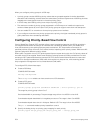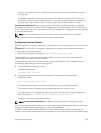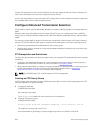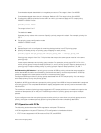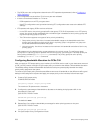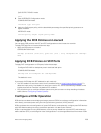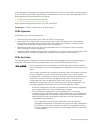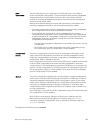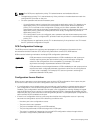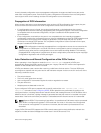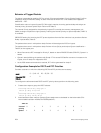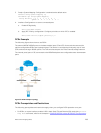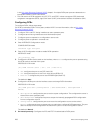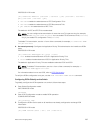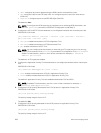
NOTE: On a DCBx port, application priority TLV advertisements are handled as follows:
• The application priority TLV is transmitted only if the priorities in the advertisement match the
configured PFC priorities on the port.
• On auto-upstream and auto-downstream ports:
– If a configuration source is elected, the ports send an application priority TLV based on the
application priority TLV received on the configuration-source port. When an application
priority TLV is received on the configuration-source port, the auto-upstream and auto-
downstream ports use the internally propagated PFC priorities to match against the received
application priority. Otherwise, these ports use their locally configured PFC priorities in
application priority TLVs.
– If no configuration source is configured, auto-upstream and auto-downstream ports check
to see that the locally configured PFC priorities match the priorities in a received application
priority TLV.
• On manual ports, an application priority TLV is advertised only if the priorities in the TLV match
the PFC priorities configured on the port.
DCB Configuration Exchange
The DCBx protocol supports the exchange and propagation of configuration information for the
enhanced transmission selection (ETS) and priority-based flow control (PFC) DCB features.
DCBx uses the following methods to exchange DCB configuration parameters:
Asymmetric DCB parameters are exchanged between a DCBx-enabled port and a peer port
without requiring that a peer port and the local port use the same configured
values for the configurations to be compatible. For example, ETS uses an
asymmetric exchange of parameters between DCBx peers.
Symmetric DCB parameters are exchanged between a DCBx-enabled port and a peer port but
requires that each configured parameter value be the same for the configurations
in order to be compatible. For example, PFC uses an symmetric exchange of
parameters between DCBx peers.
Configuration Source Election
When an auto-upstream or auto-downstream port receives a DCB configuration from a peer, the port
first checks to see if there is an active configuration source on the switch.
• If a configuration source already exists, the received peer configuration is checked against the local
port configuration. If the received configuration is compatible, the DCBx marks the port as DCBx-
enabled. If the configuration received from the peer is not compatible, a warning message is logged
and the DCBx frame error counter is incremented. Although DCBx is operationally disabled, the port
keeps the peer link up and continues to exchange DCBx packets. If a compatible peer configuration is
later received, DCBx is enabled on the port.
• If there is no configuration source, a port may elect itself as the configuration source. A port may
become the configuration source if the following conditions exist:
– No other port is the configuration source.
– The port role is auto-upstream.
– The port is enabled with link up and DCBx enabled.
– The port has performed a DCBx exchange with a DCBx peer.
– The switch is capable of supporting the received DCB configuration values through either a
symmetric or asymmetric parameter exchange.
262
Data Center Bridging (DCB)



